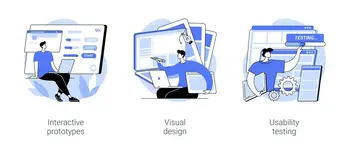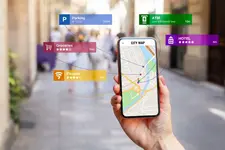
Table of contents
Interactive product demos are now a big part of selling software-as-a-service (SaaS) to other businesses. They let customers try the product themselves, so they can see how it works and what it can do. This is better than just telling them about it or showing them pictures, especially if the product is complicated. Companies now realise that there is a good chance of sales success with interactive product demos as the driver.
Interactive product demos can lead to a
25% increase in sales
leads and an
8.5% increase in the number of sales
. This is because the demos can be customized to fit the needs of each customer. Salespeople can use the demos to show how the product can solve the customer’s problems.
Interactive product demos can also be used to get leads. They can be easily shared through email, social media, or buttons on the company’s website. Salespeople can use A/B testing to learn what works best to get people to watch the demos and then buy the product. There are companies like
Navattic
,
Reprise
,
Demostack
,
Arcade
, and
GoConsensus
that make it easy to create interactive product demos.
In conclusion, interactive product demos are very helpful for B2B SaaS companies. They can help salespeople close more deals, increase sales, and get more leads. By giving customers a personalized demo experience, companies can create loyal customers who see the value of the product and become advocates for the company.
What are interactive product demos?
Interactive product demos are a cool way to show people what a product does. They are different from regular demonstrations because people can actually use the product themselves. This lets people see how the product works and if it is what they need.
Interactive product demos are found online. They often have moving pictures, videos, and games that make them fun to use. People can click on things and see how the product reacts. They can also try out different features to see which ones they like best.
Interactive product demos are a great way to learn about a product. They are more fun than reading a manual and they can help people decide if they want to buy the product.
Here are some of the key features of interactive product demos:
Hands-on exploration: People can actually use the product’s features and see how they work.
Scenario simulations: People can try out different situations to see how the product would work in different situations.
Customization: People can choose which features they want to explore and how they want to use the product.
Real-time feedback: People get help if they get stuck or if they don’t understand how something works.
Data capture: The demo can collect data about how people use it, which can help the company improve the product.
Engaging multimedia: The demo uses moving pictures, videos, and games to make it fun and interesting to use.
Remote accessibility: People can access the demo from anywhere with an internet connection.
Interactive product demos are a great way to learn about a product and decide if it is right for you. They are more fun and interactive than regular demonstrations, and they can help you make better decisions.
The Benefits of Interactive Product Demos for Sales

Interactive product demos are a great way for sales teams to show off their product’s features, answer questions, and help customers make a decision. They can be used at any stage of the sales funnel, from lead generation to closing deals.
1. Increased Engagement
Interactive product demos are a great way to show people how your product works. They let people try out the product themselves and see how it can help them. This is better than just telling people about the product because it lets them see for themselves.
A study found that interactive content gets people to convert twice as often as passive content. This means that interactive product demos can help you sell more products.
Interactive product demos can be used at different points in the sales process, from when you first meet a prospect to when they are using your product. This makes them a very versatile tool.
Interactive product demos can also help you learn more about your customers. By tracking how people use your demos, you can see what features they are interested in and what they are struggling with. This information can help you improve your product and your sales process.
There are many different types of interactive product demos, so you can find one that works for your product and your target audience. Some popular types of interactive product demos include product tours, personalized demos, and interactive product videos.
Overall, interactive product demos are a great way to engage with prospects and customers, learn more about them, and drive sales. If you are not using interactive product demos, you should start!
2. Personalization

Personalization is a powerful tool that can help businesses connect with their customers. By making the demo experience specific to each person’s needs, goals, and expectations, businesses can increase interest and show that the product is relevant. This can lead to more sales, as customers feel understood and valued.
A study by Epsilon found that
80% of consumers
are more likely to do business with a company that offers a personalized experience. This shows how important personalization is in today’s market.
There are many ways to personalize interactive product demos. Here are a few examples:
- Tailor the demo to the customer’s industry or job title.
- Highlight features that are most relevant to the customer’s pain points.
- Use the customer’s name and company information throughout the demo.
- Send a personalized follow-up email with additional resources and information.
By using these personalization tactics, businesses can create a demo experience that feels tailored to each individual customer.
One way to achieve personalization is to use interactive product demo software, such as
Usetiful
or
Userpilot
. These tools allow businesses to create customized demo experiences that can be tailored to each customer’s unique needs and interests.
In addition to increasing engagement and sales, personalization can also help businesses stand out from the competition. By providing a demo experience that feels tailored and relevant, businesses can differentiate themselves from competitors who offer a more generic demo experience.
Overall, personalization is a powerful tool that can help businesses increase engagement, sales, and customer loyalty. By incorporating personalization tactics into their interactive product demos, businesses can create a demo experience that feels tailored and relevant to each individual customer.
3. Valuable Insights

Interactive product demos are a great way for sales teams to show off their product features and help customers understand how the product can solve their problems. These demos are also interactive, so customers can click on things and learn more about the product at their own pace. This makes the demos more engaging and informative for customers.
Interactive product demos also provide valuable insights for sales teams. By tracking things like how long customers spend on each page of the demo, what buttons they click on, and whether they sign up for a free trial, sales teams can learn more about how customers are interacting with the product. This information can help sales teams improve their demos and make them more effective.
In addition to providing insights, interactive product demos can also help sales teams identify new opportunities for lead generation and product-led growth. For example, if a customer spends a lot of time on a particular page of the demo, that could be a sign that they are interested in that feature. Sales teams can then follow up with that customer to learn more about their needs and see if they are a good fit for the product.
Overall, interactive product demos are a powerful tool for sales teams. They can help sales teams showcase their product features, address customer pain points, and move prospects through the sales funnel. If you are looking for a way to improve your sales process, I encourage you to consider using interactive product demos.
4. Immersive Learning Experience
Interactive demos are a great way to learn about a product. They give users and prospective customers a chance to explore the product’s features and functionalities in a hands-on way using an interactive video. This helps users to understand how the product works and how it can be used. Interactive demos are also more engaging than traditional demos, which can offer a great customer experience.
5. Tailored Demonstrations
Tailoring product demonstrations to individual customer needs is a smart way to show that you understand and care about their problems and wants. Interactive product demos can be customized to show exactly how a product can solve a customer’s problems. This is better than a generic presentation because it shows that you understand the customer’s situation and it makes them feel like you are listening to them. Interactive demos can also be customized to show different features and scenarios that are relevant to the customer’s needs. This makes the demo more interesting and engaging, and it makes it more likely that the customer will buy the product.
Here are some examples of how interactive product demos can be tailored to individual customer needs:
- A software company could create a demo that shows how its software can help a small business manage its finances.
- A car dealership could create a demo that shows how a particular car model can meet the needs of a family with young children.
- A clothing company could create a demo that shows how its clothes can flatter a customer’s body type.
By tailoring product demonstrations to individual customer needs, businesses can show that they value their customers and that they are committed to helping them solve their problems. This can lead to more sales and a stronger customer base.
6. Real-time Problem Solving

Interactive demos are better than static presentations because they let customers try the product themselves. This helps customers understand how the product works and solve problems right away. Customers can explore different features, ask questions, and get help if they need it. This shows that the business is responsive to customer needs and that the product is easy to use. This can lead to more sales and long-term customers.
7. Visualisation of Benefits
The old saying ‘seeing is believing’ is very true in sales. Interactive product demos let customers see your product in action, so they can better understand how it will benefit them. This is much better than just reading about the product or looking at pictures.
With an interactive demo, customers can interact with the product and see how it works for themselves. This helps them to better understand the product’s features and how it can solve their problems. It also helps them to feel more confident about making a purchase.
Interactive demos are a great way to shorten the sales cycle and close more deals. They give customers the information they need to make a decision quickly, and they help to build trust and confidence.
If you’re selling a product, I highly recommend using interactive product demos. They are a powerful tool that can help you to increase sales and grow your business.
8. Higher Engagement and Longer Attention Spans

Interactive product demos are better than passive content at keeping people’s attention. They are more engaging because they let people explore the product themselves. This makes people pay more attention and learn more about the product. When people spend more time interacting with a product demo, they are more likely to buy it.
Here is a more detailed explanation:
- Interactive product demos are dynamic and interactive, which means that people can control them and see how the product works. This is more engaging than passive content, like a video or a presentation, where people just watch.
- Interactive product demos let people explore the product at their own pace and in their own way. This helps them learn more about the product and how it can help them.
- Interactive product demos are more memorable than passive content. This is because people are more engaged and involved when they are interacting with a product demo.
- Interactive product demos can help people make better decisions about whether or not to buy a product. This is because they can learn more about the product and how it can help them.
Overall, interactive product demos are a great way to keep people’s attention, educate them about your product, and help them make better decisions about whether or not to buy it.
9. Data Insights for Refinement

Product demos can give businesses valuable information about how customers use their products. By tracking how users interact with the demo, businesses can see which features are most popular, where users spend most of their time, and when they lose interest. This data can be used to improve the demo itself and to make changes to the product based on what customers want.
For example, if a business sees that users are spending a lot of time on a particular feature, they might decide to highlight that feature in the demo. Or, if they see that users are dropping out of the demo at a certain point, they might need to make that part of the demo more engaging.
By using the data from product demos, businesses can create products that are more user-friendly and that better meet the needs of their customers. This can lead to improved customer satisfaction and increased sales.
10. Remote Accessibility
In the world today, where people work remotely and markets are connected all over the world, interactive product demos are more important than ever. They are a bridge between businesses and potential customers from different countries. Interactive demos can show products to people all over the world, no matter where they are. This breaks down the barriers of distance and time zones, so businesses can talk to prospects no matter where they are. Interactive demos are a must-have for businesses that want to reach new markets, build relationships with people in other countries, and show the benefits of their products to people all over the world.
Interactive product demos are changing the way products are presented. In a world where people are always connected and doing things online, businesses that use interactive demos can reach a wider audience and show their products to people all over the world. This makes it possible for businesses to take advantage of global markets and build a bigger customer base. Interactive product demos also help businesses to be more inclusive. They can show products to people who may not be able to travel to see them in person. This makes it possible for businesses to reach a wider range of people and show them the benefits of their products.
Interactive product demos are a symbol of innovation. They allow businesses to reach people all over the world and show them their products in a way that was not possible before. This gives businesses a competitive edge and allows them to grow their business.
11. Memorable Brand Experience

A good interactive demo can make a lasting impression on your brand. When customers are engaged and informed, they will remember your product and your company. This can help you connect with customers on a deeper level and build trust.
A well-designed interactive demo is more than just a video or a presentation. It is a dynamic experience that allows users to explore your product and learn how it works. This makes it more engaging and informative than a traditional demo.
A great interactive demo should be:
- Engaging: It should keep users interested and wanting to learn more.
- Informative: It should provide clear and concise information about your product.
- Interactive: It should allow users to explore your product and learn how it works.
- Personalized: It should be tailored to the specific needs of your target audience.
If you create a great interactive demo, you can use it to:
- Generate leads: You can use the demo to attract new customers and generate leads.
- Increase sales: You can use the demo to close deals and increase sales.
- Improve customer satisfaction: You can use the demo to improve customer satisfaction and loyalty.
12. Competitive Edge
Using interactive demos in your sales strategy is a great way to stand out from the competition. It shows that you are committed to building real relationships with your customers. Traditional sales methods are boring and one-sided. Interactive demos are more engaging and allow customers to learn about your product on their own terms. This builds trust and confidence in your brand, and it makes customers more likely to buy from you.
Interactive demos are also a great way to show customers how your product can solve their problems. You can walk them through specific features and use cases, and they can see for themselves how your product can benefit them. This is much more effective than just telling them about your product’s features.
If you want to be ahead of the competition, you need to use interactive demos in your sales strategy. They are a great way to build relationships with customers, show them how your product can solve their problems, and ultimately close more sales.
How do you make an interactive product demo?
Creating an effective interactive product demo needs careful thinking, imagination, and good computer skills. Here are some steps to help you make a good interactive product demo:
i. Define Objectives and Audience
Determine the goals of your demo. Are you showcasing a new feature, solving a specific problem, or demonstrating the product’s overall capabilities? Identify your target audience and tailor the demo to their needs and preferences.
ii. Storyboard and Flow

Outline the user journey through the demo. Create a storyboard that defines the sequence of interactions and scenarios users will engage with. This will help you organise the content logically.
iii. Choose the Right Platform
Decide where the interactive demo will be hosted. It could be on your website, a dedicated landing page, or a third-party platform. Ensure the platform supports the level of interactivity you intend to create.
iv. Gather Assets
Collect multimedia assets such as images, videos, animations, and graphics that will be used in the demo. These assets will enhance the user experience and convey information more effectively.
v. Design User Interfaces (UI)
Create the interactive UI elements users will interact with. Design buttons, menus, sliders, and other clickable elements that mimic the actual product’s interface.
vi. Develop Interactive Elements
Depending on your technical expertise, you can use various tools for development, such as HTML/CSS, JavaScript, or specialised software. Develop the interactive components, ensuring they respond accurately to user inputs.
vii. Craft Scenarios
Develop scenarios that guide users through various use cases. Show how the product solves problems or meets specific needs. These scenarios should align with your target audience’s pain points.
viii. Provide Guidance
Incorporate tooltips, pop-up explanations, and instructions to guide users as they interact with the demo. Ensure that users understand the purpose and functionality of each interactive element.
ix. Incorporate Feedback Mechanisms

Allow users to provide feedback or ask questions during the demo. This can be done through chatbots, contact forms, or live chat features, ensuring a seamless user experience.
x. Optimise for User Experience
Focus on delivering a smooth and intuitive user experience. Ensure that the interactive elements load quickly, are responsive across devices, and function flawlessly.
xi. Test Thoroughly
Once the demo is polished and error-free, launch it on the chosen platform. Promote the demo through your website, social media channels, email campaigns, and other relevant channels.
xii. Gather Analytics
Implement analytics tools to track user interactions within the demo. This data will help you understand user behaviour, identify popular features, and make improvements.
xiii. Iterate and Improve
Based on user feedback and analytics, continuously refine and improve the interactive demo. Update content, fix any issues, and add new scenarios to keep the demo relevant and engaging.
Creating an interactive product demo requires a combination of design, development, and user experience considerations. By carefully planning and executing each step, you can create a demo that effectively engages users and showcases the value of your product.
Conclusion
In conclusion, using interactive product demos is a great way to sell more products. These demos are more engaging than traditional pitches and can help businesses understand their customers better. Interactive demos can be tailored to specific customers and can help businesses resolve problems in real-time. This shows customers that businesses are committed to their satisfaction. Interactive demos also make businesses look like leaders in their industry. They show that businesses are willing to try new things and that they care about giving customers a great experience. As the market changes, interactive demos will become even more important for businesses that want to succeed.























